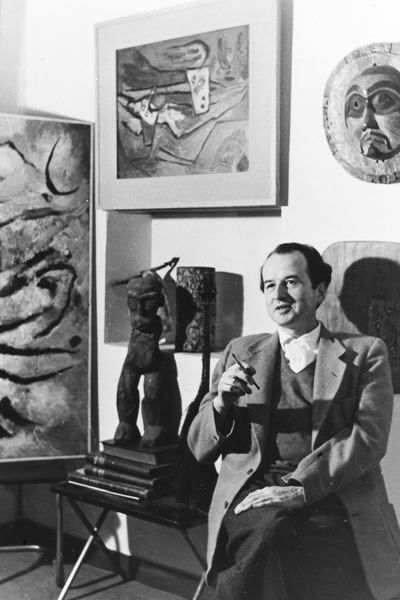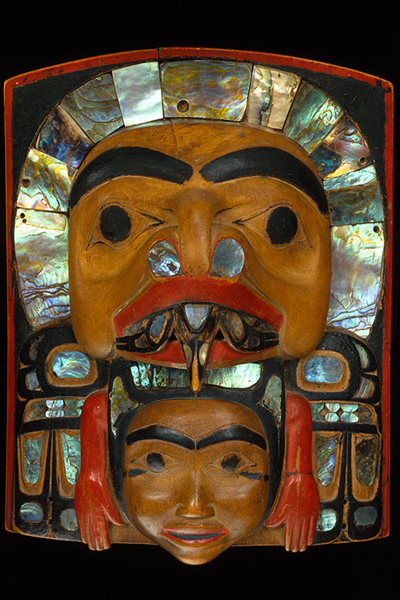Wolfgang Paalen
Unlike many other collectors of Northwest Coast art, Wolfgang Paalen (1905-1959) was an artist rather than a scholar or explorer. A Surrealist painter and theorist of American Abstract-Expressionism, his vision of a responsive, universal art resonated with the Indigenous objects he acquired. Paalen was born into wealth and privilege in Secessionist Vienna, and his family also maintained residences in Berlin and Rome. He grew up surrounded by his father’s extensive art collection, which included works by Titian, Renoir, and Delacroix. During his childhood, the museums of Vienna and Berlin held exceptional collections of Northwest Coast art and may have been where Paalen first encountered objects from this region.
In the midst of the global depression of 1929, which caused a significant reversal in his family fortune, Paalen moved to France where he experimented with an expressive abstract style that solidified his reputation as a serious artist. His early promise was confirmed through study with Hans Hofmann and Fernand Léger. Paalen soon befriended Eva Sulzer, a photographer and heiress who became a lifelong source of emotional and financial support, likely underwriting much of his later travel and acquisitions. Within a few years, he was exhibiting throughout Europe as a member of the Surrealists, having been invited into their orbit by André Breton around 1935. Paalen shared the avant-garde’s fascination with “primitive” art, and in the late 1930s he purchased from a Paris gallery his first Northwest Coast art—a model argillite totem pole.
Encouraged by the experience of Kurt Seligmann, a fellow Surrealist who had acquired a Witsuit’en totem pole from northern British Columbia for the Musée de l’Homme, Paalen booked passage to the Northwest Coast in May 1939 for himself, his wife Alice Rahon, and Eva Sulzer. Stopping en route in New York City, he laid the groundwork for his own collection by frequenting the American Museum of Natural History, George Heye’s Museum of the American Indian, and commercial galleries. He secured storage with a Manhattan warehouse company to which he could forward his acquisitions. From New York, Paalen and his companions traveled by train across Canada to British Columbia and then by steamer to Alaska.
Paalen spent the next two months immersing himself in Pacific coastal cultures and collecting First Nations art with such enthusiasm that his reputation began to precede him. In Ketchikan, he reported that “an old gold digger [called] out to me in the street, he has heard that I’m looking for ‘Indian relics’.” In short order, he purchased a whalebone bowl, a ceremonial hat, and a “very beautiful” Tlingit headdress. Such works of art, Paalen mused, “are traps set for life—if the trap is well set, life is snared within it forever.”
By early August, Paalen arrived on Vancouver Island, where he later recalled purchasing the Simeon Sdiihldaa frontlet, illustrated in Plate 47 of Boas’s 1897 book. In less than three months, Paalen collected over 40 objects, including a monumental Tlingit interior screen, mostly by combing through coastal curio shops. Sulzer documented the trip in over 300 photos. While in British Columbia, Paalen became friendly with collectors William A. Newcombe (son of Charles Newcombe) and George Emmons, both of whom he would correspond with for several years. In late August 1939, as Germany prepared to invade Poland, an avant-garde, part Jewish artist such as Paalen would have found no welcome in wartime Europe. At the suggestion of his friend Frida Kahlo, Paalen, Rohan, and Sulzer began to build a new life in Mexico.
Paalen evinced a deep emotional connection with the pieces in his possession. Upon his move to Mexico, he lived and worked surrounded by them. He amassed a library of books devoted to the Northwest, including rare first editions of Cook’s eighteenth-century voyage journals. Paalen made a particularly close study of Boas’s 1897 monograph, which paralleled his own rejection of Social Darwinism. Frustrated with the limitations of European Surrealism, Paalen broke with the movement in 1940. He synthesized his own theories on Indigenous art in essays for his magazine, DYN, a journal of art criticism and theory that would go on to influence the younger artists of the American Abstract Expressionist movement, in particular Robert Motherwell (who produced some of his earliest pieces while working in Paalen’s studio). In his piece on “Totem Art” for the journal’s influential 1943 Amerindian issue, Paalen directly referenced Boas’s theories and drew on anthropology to acclaim Indigenous work as manifestations of universal artistic expression.
Paalen sold off most of his collection, including the Sdiihldaa frontlet, by the early 1950s. Beset by accusations that he had illegally exported Mesoamerican antiquities, he committed suicide in 1959.
By Sarah Reetz
Objects Collected by Paalen
SOURCES:
Browne, Colin. I Had an Interesting French Artist to See Me this Summer: Emily Carr and Wolfgang Paalen in British Columbia. Vancouver: Vancouver Art Gallery, 2016.
Chénieux-Gendron, Jacqueline. “Surrealists in Exile.” In Exile and Creativity: Signposts, Travelers, Outsiders, Backward Glances, edited by Susan Rubin Suleiman, 163-179. Durham, NC: Duke University Press, 1998.
Mauzé, Marie. “Surrealists and the New York Avant-Garde, 1920-60.” In Native Art of the Northwest Coast: A History of Changing Ideas, edited by Charlotte Townsend-Gault, Jennifer Kramer and Ḳi-ḳe-in, 270-303. Vancouver: University of British Columbia Press, 2013.
———. “Totemic Landscapes and Vanishing Cultures through the Eyes of Wolfgang Paalen and Kurt Seligmann.” Journal of Surrealism and the Americas 2, (2008): 1-24.
Onslow-Ford, Gordon. “Paalen The Messenger.” In Hommage to Wolfgang Paalen: On the Occasion of the Exhibition of his Paintings at the Museo de Arte Moderno, Mexico, 1967, 24-26. Mexico City, D.F.: Museo de Arte Moderno, 1968.
Paalen, Wolfgang. “Totem Art.” Dyn: Amerindian Number, 4-5. Coyoacan, D.F., Mexico: Printed at Talleres Gráficos de la Nación, 1943.
Usabiaga, Daniel Garza. “Anthropology as Science, Anthropology as Politics: The Lessons of Franz Boas in Wolfgang Paalen’s Amerindian Number of DYN.” Anales del Instituto de Investigaciones Estéticas, Vol XXXIII, nr. 98 (2011): 175-200.
Winter, Amy. “The Germanic Reception of Native American Art: Wolfgang Paalen as Collector, Scholar, and Artist.” European Review of Native American Studies Vol. 6, no. 1, (1992): 17-26.
———. Wolfgang Paalen: Artist and Theorist of the Avant-Garde. Westport, CT: Praeger, 2002.


